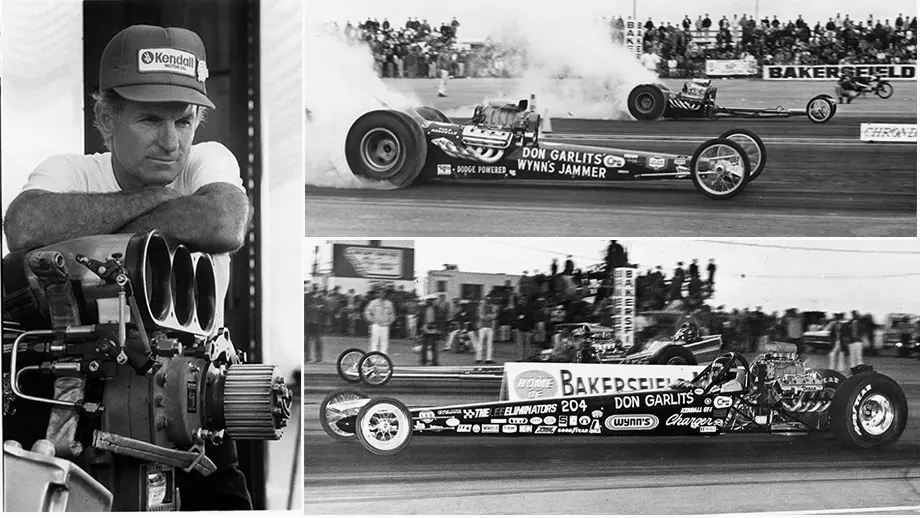The big news earlier this month was that “Big Daddy” Don Garlits was coming west from Florida to Bakersfield for the California Hot Rod Reunion, retracing in a way one of the seminal moments of his career.
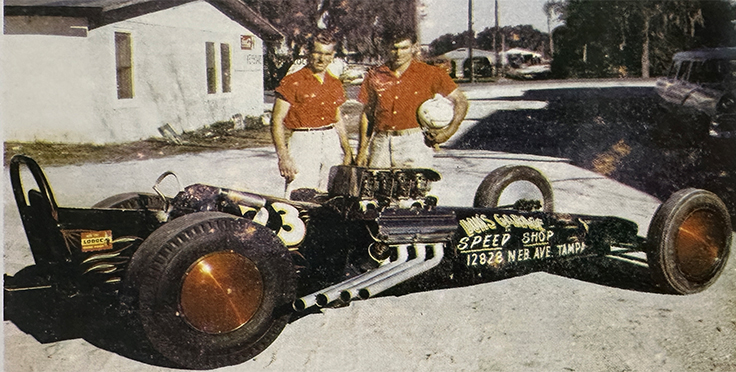
Ed and Don Garlits, circa 1957
It was 1959, and Garlits had been making big headlines back east the previous two years with clockings that the California crowd refused to believe. He had won the ATAA World Series event in Cordova, Ill., outlasting California hotshots like Cook & Bedwell, and had powered Swamp Rat I to a stunning 8.76 at 176.40 mph in Brooksville, Fla., the quickest and fastest times ever recorded.
The California boys read the headlines in Drag News, but wanted to see “Don Garbage” do it with their own eyes and arranged a race on neutral ground in Houston in June 1958, where Garlits cleaned up, beating their best, which was Pete Ogden in Romeo Palamedes’ dragster, Jack Ewell in the Jado-Kamboor Special, and Red Case in a rear-engine car that later would claim his life. Garlits beat them all and set low e.t. and top speed. You can read all about that race in this column I wrote about the event years ago.
After Garlits ran 180 mph — again in Brooksville — in late 1958, the West Coasters dared “Big” to come west and race them on their home turf in early 1959 for the first Fuel & Gas Championships. Garlits demanded an outrageous appearance fee ($4,500, or about $50,000 in 2025 money, which was probably way more than Garlits’ entire operation was worth) to come west for a three-race series in Bakersfield, Kingdon Dragway (in Northern California), and Chandler, Ariz., but the Californians agreed to put the cash up.
Garlits didn’t trust them California boys any more than they trusted his headlines, so he had Ed Iskenderian hold the money.
“People don’t realize that at that time, the 1959 race was the biggest race in the history of the sport,” Garlits explained. “Even the NHRA and AHRA national events weren’t pulling crowds like that. It was a really big meet, and it got everybody’s attention.”
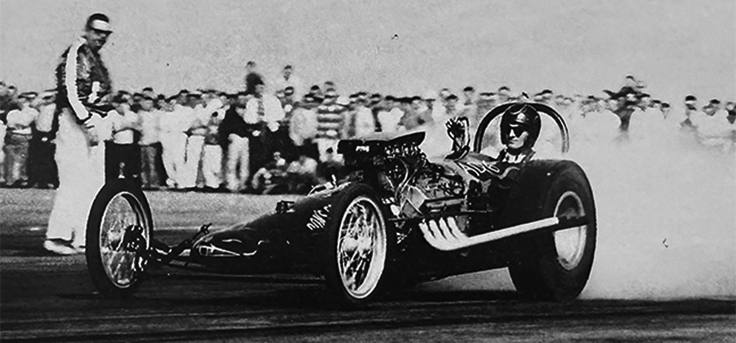
Most of his West Coast competitors were running blowers, but Garlits was still running his reliable Stromberg carburetor setup, and he felt confident in his skills. The first race was the famed Smokers Car Club meet in Bakersfield, and the West Coasters got a real laugh out of Garlits’ woes.
Garlits ran low nines at 172 mph in time trials, and while the e.t.s among the competition were about equal, the supercharged opposition was running 180 mph.
To make matters worse, as Garlits was firing up his engine on a cold morning before racing Don Hampton, a connecting rod snapped. The Californians got a big laugh out of that. Don Garbage indeed.
“I wasn’t used to that kind of weather,” Garlits told me last week. “I should have warmed the car up on alcohol. I wasn’t thinking straight.”
Iskenderian told Garlits what he probably already knew, that if he was going to continue to lead the pack, he’d have to ditch his trusty carbureted setup and bolt a blower atop the manifold. Phil Weiand supplied the manifold atop which a 6-71 blower was mounted and topped with eight Strombergs. Garlits got a 392 block from a wrecking yard (those were the days, eh?) and added a C&T 454 stroker kit.

“I didn’t really want to put a blower on it,” he told me, “but Iskenderian said the days of naturally aspirated were over. He could see the future, and he made two blower kits, one for me and one for Setto Postoian.”
Garlits towed back north to Kingdon, and cleaned house, running low e.t., top speed (174 mph), and beat Tony Waters and the Waters & Sughrue A/Modified Roadster in the final, then towed east to Chandler and wiped the floor again, setting a new e.t. record of 8.43 in the process.
Although he had proved his mettle, the California crew was delighted that Garlits did not win Bakersfield, and he would not win it until 1965, and every time he didn’t win, it seemed as big a story as who had actually won. The Bakersfield event was still a huge deal in those days, especially in the early 1960s when the nitro ban was still in place.
Garlits finally won the U.S. Fuel & Gas Championships in 1965, the year after he had runner-upped to Connie Kalitta, so it was clear he was getting closer, and it came on the heels of his second NHRA Winternationals win in the past three years. Garlits beat his shop partner, “Starvin’ Marvin” Schwartz, in the final round. Garlits later won the NHRA Nationals in Indy to complete his sweep of 1963’s “big three” nitro events.
Garlits lists Bakersfield 1965 up alongside Indy 1967, Ontario 1975, and Indy 1984 as one of his greatest wins. He brought three cars west: his Swamp Rat 6, the famed 200-mph car that also had been to England the previous year; Connie Swingle in the now-426-powered Swamp Rat 8, and Schwartz in another Garlits-built car called the Garlits Chassis Special.
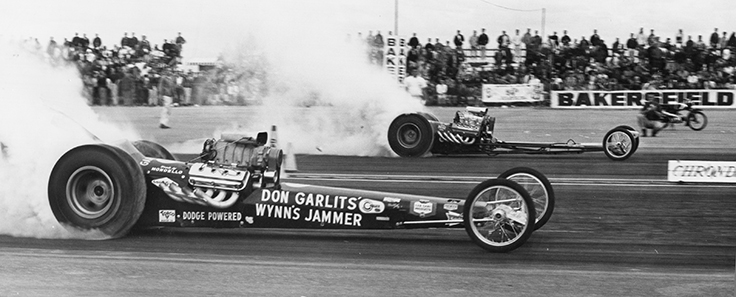
Garlits whipped the 64-car field on Saturday, which gave him the right to sit out Sunday’s 32-car race, but he ended up driving Schwartz’s car instead (Schwartz was having difficulty driving the car due to some tuning changes) and Garlits won that race, too — 11 straight rounds over two days. Schwartz got back in the car for the Saturday vs. Sunday runoff (since Garlits clearly couldn’t race himself), and Garlits won that race, too, driving through an oildown to claim his 12th straight win light.
“I remember I was getting ready for the final round against Marvin, and I told my wife, Pat, ‘I gotta beat that kid. You know, he’s been awful good on the flag.’ And my wife says, ‘My God, honey, we’re going to get all the money no matter who wins. You’re already the greatest name in drag racing. What more do you want?’ I said, ‘I want to win this.’ ’’ And he did.
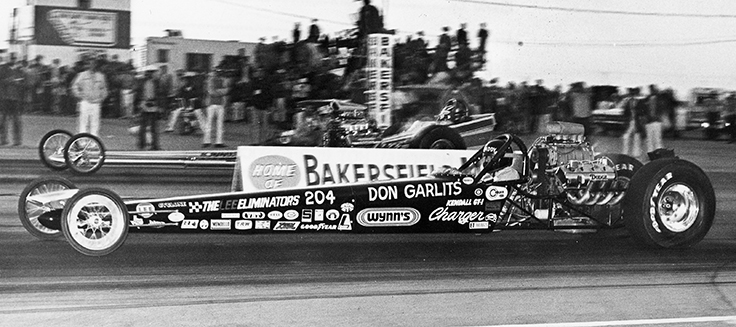
Garlits didn’t win Bakersfield again until 1971 in his revolutionary Swamp Rat 14, again following a Winternationals win — the shot heard ‘round the drag racing world — beating Rick Ramsey and the front-engine Keeling & Clayton car on a holeshot in the Bakersfield final, 6.71 to 6.64.
Bakersfield hero James Warren won the March Meet three straight years (1975-77), then was bounced early, alongside Garlits, in 1978. In 1979, Warren stunningly failed to make the now 16-car field, and Garlits — who equally surprisingly had failed to qualify at the Winternationals — went on to win his third March Meet crown in Swamp Rat 24. After qualifying No. 1, “Large Father” went on to again beat Ramsey in the final round.
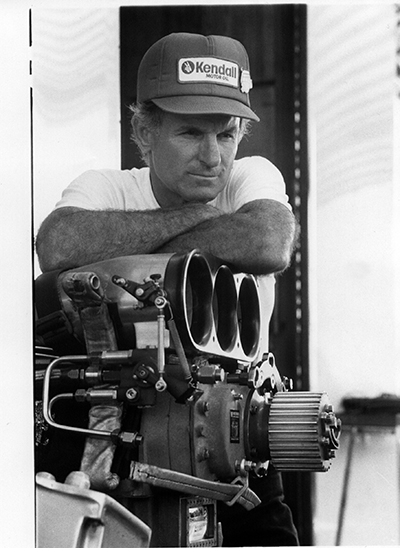
Interest in the March Meet began to flag in the early 1980s, and even though Garlits won the 1986 and 1987 titles with his streamlined Swamp Rat XXX, it wasn’t the same. Garlits defeated the eight-car field in 1986, beating Gary Beck and Dan Pastorini in the final two rounds, and did make a stunning 5.37 pass against Beck, then won the 1987 event when Larry Sutton — who had been the first to reach Garlits after he was maimed in the 1970 Lions Drag Strip transmission explosion — red-lighted in the final.
Garlits ended up winning the famed March Meet five times, forever cementing his name as part of the lore of one of the most historic dragstrips on the West Coast, and his return this year — even though he’s driving a motorhome west instead of towing a race car — is every bit as much a big deal.
“Big” and Bakersfield. They still go together.
The California Hot Rod Reunion, presented by Good Vibrations Motorsports and featuring Nitro Revival, takes place Oct. 24-26 at Famoso Dragstrip. To purchase tickets or for more information, visit nhramuseum.org, call 800.759.8679, or email CHRR@famosodragstrip.com.
Phil Burgess can be reached at pburgess@nhra.com
Hundreds of more articles like this can be found in the DRAGSTER INSIDER COLUMN ARCHIVE
Or try the Random Dragster Insider story generator

